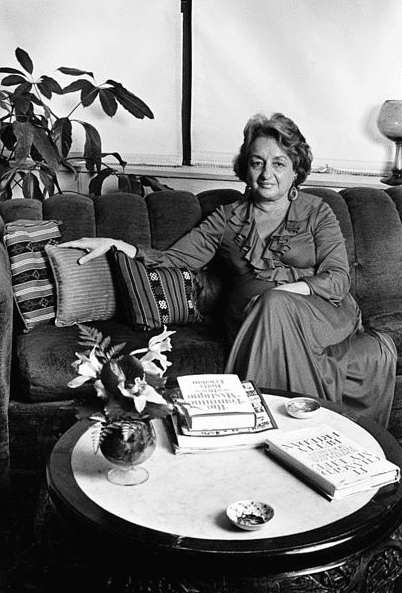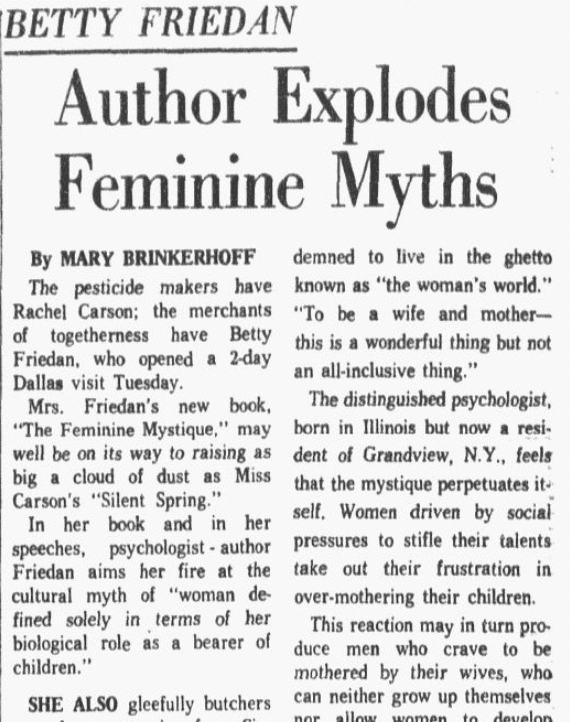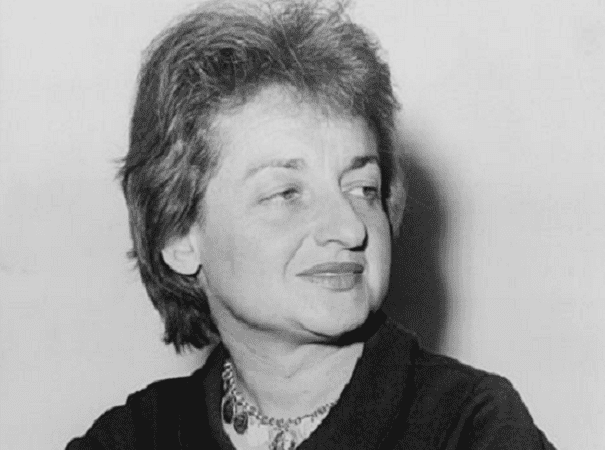On 19 February 1963, a slow, quiet revolution picked up momentum and got louder with the publication of Betty Friedan’s seminal book, The Feminine Mystique, which spurred growth and interest in the feminist movement. This groundbreaking work grew out of a survey Friedan sent to 200 of her fellow Smith College graduates in 1957. She wanted to determine if her ex-classmates were feeling the same sense of dissatisfaction with domestic life that she was struggling with as an at-home mother raising three children.

Their responses confirmed what she suspected, and she spent the next several years researching what she called “the problem that has no name.” The culmination of this research was The Feminine Mystique. After its publication, spurred in part by lectures Friedan delivered, women began confronting the malaise in their own lives and started organizing to demand and create more opportunities for women. Three years later, Friedan helped found the National Organization for Women (NOW) in 1966 and became its first president.

BETTY FRIEDAN
Author Explodes Feminine Myths
By Mary Brinkerhoff
The pesticide makers have Rachel Carson; the merchants of togetherness have Betty Friedan, who opened a 2-day Dallas visit Tuesday.
Mrs. Friedan’s new book, “The Feminine Mystique,” may well be on its way to raising as big a cloud of dust as Miss Carson’s “Silent Spring.”
In her book and in her speeches, psychologist-author Friedan aims her fire at the cultural myth of “woman defined solely in terms of her biological role as a bearer of children.”
She also gleefully butchers sacred cows ranging from Sigmund Freud and anthropologist Margaret Mead to Hollywood star Doris Day, “the epitome of the feminine mystique… the happy housewife heroine.”
Mrs. Friedan, herself the mother of three children, is the Paul Revere of what she calls “a delayed revolution” – a crusade she hopes will give the supposedly emancipated American woman the right to be human as well as female.
She spoke Tuesday at the annual donor luncheon of the Sisterhood of Temple Emanu-El. A record crowd of more than 600 packed Tobian Auditorium at the temple.
Rabbi Levi Olan introduced the speaker and remarked afterward in his best deadpan manner that the male view would be given equal time next year.
On Wednesday, Mrs. Friedan will be at SMU for a 6 p.m. dinner with women student leaders from several campuses and a 7:30 p.m. lecture sponsored by the Associated Women Students.
Her topic at the Tuesday luncheon, for which Mrs. Arnold Darrow and Mrs. Sam Stone were cochairmen, was A New Image of Woman.
This image, in her view, must replace the “feminine mystique,” a myth sanctioned by misapplication of Freudian psychology and sustained by those whose welfare depends on the sale of products designed to provide glamour or enhance the housewife’s role.
Whatever their rights on paper, Mrs. Friedan does not consider American women truly free as long as they are condemned to live in the ghetto known as “the woman’s world.” “To be a wife and mother – this is a wonderful thing but not an all-inclusive thing.”
The distinguished psychologist, born in Illinois but now a resident of Grandview, N.Y., feels that the mystique perpetuates itself. Women driven by social pressures to stifle their talents take out their frustration in over-mothering their children.
This reaction may in turn produce men who crave to be mothered by their wives, who can neither grow up themselves nor allow women to develop their gifts.
Mrs. Friedan, a researcher with a healthy irreverence for undigested statistics, cautioned her listeners against being misled by the fact that one-third of U.S. women work outside their homes.
The majority, she asserted, are not contributing their true potential to a world in desperate need of their talents. They are working below the level of their abilities and often merely in order to put a husband or a child through school.
This waste of talent carries over into volunteer work, where professionals make the decisions, and politics, where women generally just “lick envelopes.”
Ultimately, Mrs. Friedan believes, women themselves are to blame for keeping these shackles, and they must free themselves. They must demand the right to be taken seriously as people, not just as consumers.
The speaker gave the back of her hand to successful career women who oppose similar success for others. She did not identify these experts in her Tuesday talk.
But Margaret Mead, anthropologist and writer famed for her studies of primitive societies, is named in a similar context in Mrs. Friedan’s book.
“It’s very interesting that the women who tell other women to stay in the kitchen do so from the platform or the TV studio… Some women are terrible cooks and would be better off in the physics laboratory.”
Note: An online collection of newspapers, such as GenealogyBank’s Historical Newspaper Archives, is not only a great way to learn about the lives of your ancestors – the old newspaper articles also help you understand American history and the times your ancestors lived in, and the news they talked about and read in their local papers – including more recent events.
Explore over 330 years of newspapers and historical records in GenealogyBank. Discover your family story! Start a 7-Day Free Trial
Related Articles:
